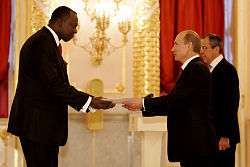Letter of credence
A letter of credence (French: Lettre de créance) is a formal diplomatic letter that appoints a diplomat as ambassador to another sovereign state. Commonly known as diplomatic credentials, the letter is addressed from one head of state to another, asking him to give credence (French: créance) to whatever the ambassador may say on his country's behalf. The letter is presented personally by the ambassador to the receiving head of state in a formal ceremony, marking the beginning of the ambassadorship.
Letters of credence are traditionally written in French, the lingua franca of diplomacy.[1] However, they may also be written in the official language of the sending state.[2][3]
Presentation of credentials

Upon arrival at his post, an ambassador meets with the foreign minister to arrange for an audience with the head of state.[4] The ambassador carries both a sealed original and an unsealed copy of his credentials. The unsealed copy is given to the foreign minister upon arrival, and the original is presented personally to the head of state in a formal ceremony.[5]:550 Ambassadors do not begin their duties until their credentials are accepted, and their precedence within the diplomatic corps is determined by the date on which the credentials were presented.[6] However, ambassadors are entitled to diplomatic immunity as soon as they enter the country.[7]:32[8]:261
The ambassador travels to the presentation ceremony in an official vehicle provided by the receiving state, accompanied by a military escort. In constitutional monarchies and parliamentary democracies, the head of state or viceroy acts according to advice (binding instructions) from the government. The foreign minister will attend (be present with) the head of state at the actual ceremony, to symbolize the fact that the credentials are being accepted on the basis of government advice.[9] The ambassador uses both hands to present his credentials to the head of state.[10]
Chargé-level relations
When two countries maintain relations at the chargé d'affaires level, the letter of credence will be written by the foreign minister of the sending state and addressed to the foreign minister of the receiving state. The chargé will present his credentials to the foreign minister.[11] The head of state is neither addressed nor presented with the credentials, symbolizing the lower level of diplomatic relations between the countries. The chargé is not entitled to a military escort or an official car.
Commonwealth
High commissioners from Commonwealth nations do not present letters of credence. When two Commonwealth realms share the same British monarch as head of state, the prime minister of the sending state writes an informal letter of introduction to the prime minister of the receiving state.[12] When a Commonwealth nation is a republic, high commissioners are dispatched and received with letters of commission, which are written by one head of state and presented to another head of state.[13][14] Both forms of letters were standardized in 1950–1951 after India became a republic, replacing a chaotic system where some high commissioners carried letters from the prime minister, some carried letters from the minister of external relations, and others carried no letters at all.[15]
References
| Wikimedia Commons has media related to Letters of credence. |
- ↑ "10th Anniversary of Poland's Accession to the EU". Ministry of Foreign Affairs, Republic of Poland. 8 May 2014.
Letters of Credence (translated from French) of Jan Kułakowski, 26 February 1990 (AMFA).
- ↑ Ahren, Raphael (October 17, 2012). "New Egyptian ambassador brings Israel 'message of peace'". The Times of Israel.
- ↑ "Diplomatic Credential Presented by the Great Qing Empire". National Palace Museum.
- ↑ "2 FAM 330 Ceremonies and Protocol Upon Assignment as Chief of Mission" (PDF). U.S. Department of State. February 28, 2012.
The new chief of mission requests, through the officer who has been acting as chargé d'affaires ad interim, an informal conference with the minister of foreign affairs or such other appropriate officer of the government in order to arrange to be received by the chief of state.
- ↑ Oppenheim, Lassa (1905). International Law: A Treatise. I.
- ↑ "Diplomatic List: Order of Precedence and Date of Presentation of Credentials". Office of the Chief of Protocol, U.S. Department of State. Retrieved 23 March 2016.
- ↑ Dopagne, Frédéric; Hay, Emily; Theeuwes, Bertold F. Theeuwes, Bertold F., ed. Diplomatic Law in Belgium. ISBN 9789046606865.
- ↑ Satow, Ernest Mason (2017). Satow's Diplomatic Practice (7th ed.). Oxford University Press. ISBN 9780198739104.
- ↑ "Presentation of Credentials". Ministry of Foreign Affairs of the Republic of Cyprus. Archived from the original on November 15, 2013.
The President of the Republic invites the Ambassador in his Office, for an audience. The Minister of Foreign Affairs and the Director of the Office of the President, also attend.
- ↑ "Procedure for Presenting the Letters of Credence by the Head of Diplomatic Mission in Montenegro". Ministry of Foreign Affairs and European Integration (Montenegro).
Then he/she approaches the President of Montenegro and formally (with both hands) presents to him the Letter of Credence and the Letter of Recall of his/her predecessor. The President of Montenegro formally accepts the letters and shakes hands with the Head of Diplomatic Mission.
- ↑ U.S. Department of State (1897). Instructions to the Diplomatic Officers of the United States. Washington, DC. pp. 1–5.
- ↑ Alison Quentin-Baxter and Janet McLean, This Realm of New Zealand: The Sovereign, the Governor-General, the Crown, 2017
- ↑ Berridge, G. R.; Lloyd, Lorna (2012). "Letter of introduction". The Palgrave Macmillan Dictionary of Diplomacy (3rd ed.). Palgrave Macmillan. p. 229. ISBN 9780230302990.
- ↑ Berridge, G. R.; Lloyd, Lorna (2012). "Letters of commission". The Palgrave Macmillan Dictionary of Diplomacy (3rd ed.). Palgrave Macmillan. p. 230. ISBN 9780230302990.
- ↑ Lloyd, Lorna (2007). Diplomacy with a Difference: the Commonwealth Office of High Commissioner, 1880-2006. Martinus Nijhoff. pp. 138–140. ISBN 9789047420590.